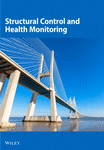AT-LSTM-CUSUM Digital Intelligent Model for Seepage Safety Prediction of Concrete Dam
Abstract
Seepage is one of the main causes of dam accidents, characterized by long latency periods and spatiotemporal randomness. In this study, an innovative combined algorithm model (AT-LSTM-CUSUM) is proposed to predict such leakage hazards. First, a long short-term memory (LSTM) network model based on an attention mechanism is established to focus on key influencing factors in predicting the time series data. Following the time series prediction, an improved Cumulative Sum (CUSUM) change-point monitoring algorithm is introduced. Within a sliding window period, a control function collects cumulative residuals, and a threshold test is performed to determine whether a potential hazard trend exists. Using monitoring data from a pressure measuring pipe in a concrete dam as the experimental subject, five related influencing factors were collected (upstream and downstream water levels, temperature, precipitation, and structural aging). These data were fed into the AT-LSTM model for iterative parameter tuning, yielding optimal prediction results. These results were compared with those of the LSTM, GRU, ARIMA, and Prophet models, validating the superior performance of the AT-LSTM model. In addition, by simulating the seepage hazard occurrence process, the change-point monitoring effectiveness of the improved CUSUM algorithm was tested. A parameter sensitivity analysis of the window period and threshold values revealed that the algorithm performed effectively in detecting seepage hazards. The innovative algorithm proposed in this paper exhibits strong early warning capabilities and holds significant value for dam safety monitoring and maintenance.
1. Introduction
Seepage is one of the main causes of dam accidents [1]. In recent years, dam accidents caused by seepage have become frequent, accounting for about 29.1% of dam failures, with 2344 at-risk reservoirs experiencing leakage issues [2]. For example, in July 2024, a severe seepage hazard occurred at the Jiufeng Reservoir dam in Hunan Province, China. Water seeped from a conduit at an elevation of 98 m (with the reservoir water level at 125.30 m). The seepage was detected by inspection personnel when significant water leakage was observed at the dam’s drainage prism toe, and timely emergency measures successfully controlled the hazard.
For such concealed seepage hazards, relying solely on manual inspections or sampling methods poses significant risks. In addition, current sampling detection methods typically rely on traditional laboratory or on-site experiments, which are costly, invasive, and time-consuming. With the growing application of intelligent technologies in dam monitoring [3], many researchers have combined these technologies with mathematical prediction models to forecast changes in dam seepage data. These methods include ARIMA time series, Prophet, support vector machine (SVM), BP neural networks, and extreme learning machines [4–14]. While these algorithms perform well in predicting dam seepage data under normal conditions, there is still a lack of research on predicting and providing timely warnings for concealed seepage hazards caused by sudden events (such as floods or earthquakes) or internal structural erosion and damage.
To address these concealed seepage hazards with spatiotemporal randomness, this paper proposes a solution that involves deploying sensors in weak areas of the dam to collect seepage data in real time. The improved combined algorithm AT-LSTM-CUSUM is then used to predict seepage data, addressing both normal seepage predictions and potential leakage accident warnings, thereby achieving real-time monitoring of dam seepage safety.
2. The Principles of the AT-LSTM-CUSUM Seepage Prediction Model
2.1. Principles of the AT-LSTM Model
2.1.1. Principles of Long Short-Term Memory (LSTM)
LSTM networks, compared with traditional neural networks, can effectively solve the forgetting problem and extend the time unit of the processed time series data. The core idea is to construct cell units that selectively remember important information based on the internal dependencies of time series, filtering out noise and reducing memory burden. The structure of LSTM includes three types of gating mechanisms: the input gate, output gate, and forget gate. The output vector of the model is divided into the current state vector and the output vector. The inputs consist of the state vector of the previous time step, the output vector of the previous time step, and the input vector of the current time step [15].
The schematic diagram of the LSTM cell structure is shown in Figure 1:
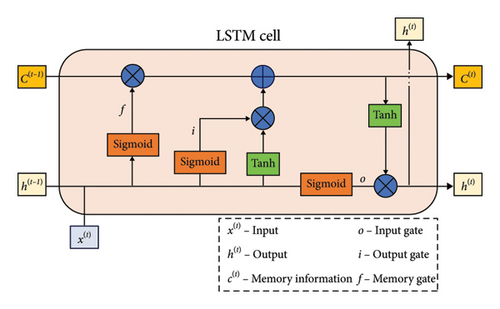
2.1.2. Attention Mechanism
LSTM is proficient at handling time series data and capturing dependencies within sequences, selectively remembering important internal information. However, it gives equal attention to all external input features, which affects prediction accuracy. Therefore, the attention mechanism is introduced, much like installing a focusing device in data processing. It allocates different weights to factors based on their importance to leakage, thereby highlighting the key influencing factors [16].
The attention mechanism involves three input vectors.
The Q(Querry), used to retrieve correlations with other variables, the K(Key), reflecting the degree of association between the corresponding input elements and the query vector, and the V(Value), which contains the actual data information [17].
- 1.
Data encoding: transform the input data into corresponding 〈K, V〉 pairs using appropriate encoding.
- 2.
Calculating relevance: determine the correlation between the query vector and each key vector. After normalization, obtain the attention weights corresponding to each input element.
- 3.
Weighted information aggregation: perform a weighted summation of each value vector based on the weight coefficients.
2.1.3. LSTM Network Based on the Attention Mechanism
-
Input layer: accepts multidimensional time series data and transforms its format.
-
Hidden layer: consists of multiple LSTM cell units that process the time series data.
-
Attention layer: computes the attention distribution at different time points.
-
Fully connected layer: transforms the data and performs local integration.
-
Output layer: delivers the prediction results.
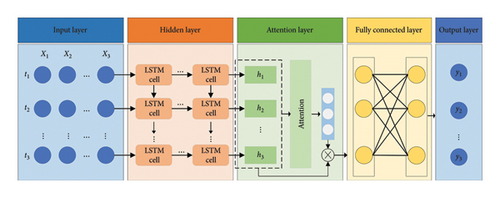
By introducing the attention mechanism, the model dynamically focuses on the importance of various factors at different time points, disregards irrelevant information, and emphasizes key data. This integration into the memory network can enhance the model’s predictive performance [18].
2.2. Improved Cumulative Sum (CUSUM) Algorithm
Dam leakage issues typically have a long latency period, and the changes in leakage behavior are often slow and covert [19]. Traditional anomaly detection methods struggle to effectively identify potential risks in the early stages. For example, factors such as water level fluctuations caused by precipitation, temperature changes, or gradual structural erosion can lead to small and slow changes in seepage flow, which often accumulate gradually without noticeable abrupt shifts. To address this challenge, an anomaly detection method capable of efficiently and sensitively capturing these progressive changes is needed. General time series anomaly detection can be based on predictive data [20]. In this paper, an innovative approach is taken by using the residuals between reasonable predicted values and actual values to assess anomalies in advance, based on a deep integration with the research problem background [21]. The residuals obtained by subtracting the actual seepage pressure values from the reasonable values predicted by the AT-LSTM model are introduced into the improved CUSUM algorithm for change point detection.
2.2.1. Algorithm Principle and Improvement Plan
-
Residual calculation: replace the mean change in the original CUSUM algorithm with the residuals between predicted and actual values. In this way, the algorithm can focus on capturing the deviation between seepage flow and reasonable predicted values, thereby mitigating the influence of external factors (such as climate or precipitation) that cause periodic fluctuations. This makes the residuals better reflect anomalies caused by structural issues or potential leakage.
-
Sliding window: we innovatively introduce a sliding window mechanism, ensuring that each monitoring node triggers a monitoring cycle, taking into account the dam’s historical data rather than relying solely on anomaly points for triggering, thus achieving real-time monitoring of leakage safety.
-
Control function: the established control function effectively manages the acceptance level of seepage data, enhancing the system’s noise resistance and change-point sensitivity. For continuously fluctuating positive residuals, the system gradually increases the acceptance level; for occasional discontinuous errors, it filters and selects based on the fluctuation amplitude, ensuring more accurate and reliable detection results.
2.2.2. Implementation Process of the Improved CUSUM Algorithm
- 1.
Use the AT-LSTM model to predict the seepage data for the next period in real-time, followed by actual measurements of the seepage data during that period.
(4) -
where i represent the monitoring time units starting from the initial monitoring point, measured in days.
- 2.
Starting from the initial monitoring point, calculate the difference between the reasonable predicted data ygt(i) and the actual measured data ypv(i) at each time point from (1). The residual value is denoted as Δy(i).
(5) - 3.
Each time a new measurement time point is reached, initiate a new monitoring window cycle Tnew from that time point Δynew.
(6)
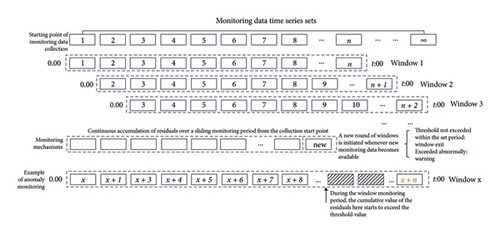
Let A(t) denote the acceptance function, which dynamically adjusts the acceptance levels to enhance noise resistance and sensitivity to change points. Continuous fluctuations in positive residuals receive sufficient attention, with increasing sensitivity and progressively higher acceptance levels. In contrast, a filtering function is applied to sporadic residuals, where the acceptance level is related to the size of the residual. Small fluctuations in sporadic residuals are accepted, while larger fluctuations result in progressively lower acceptance.
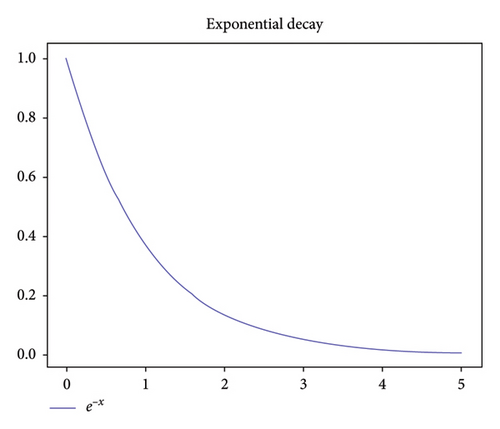
3. Engineering Case Study
3.1. Data Collection and Processing
The case study is the Ertan Hydroelectric Station in Panzhihua City, Sichuan Province, China, where the hydraulic hub is a concrete double-curvature arch dam [7]. The research data consist of the piezometric levels measured by the piezometer in the dam’s impermeable curtain from 2011 to 2019. We selected measurement point A as the primary point for pressure prediction research and introduced data from two other points, B and C, for model validation, which are shown in Figures 5 and 6.
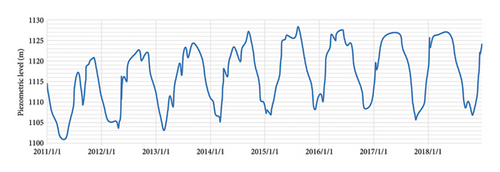

From Figure 7, it can be observed that the seepage pressure data exhibits annual periodicity, with values ranging from (1100.893 to 1128.329) m. It can be indirectly inferred that the seepage amount shows a slight year-on-year increase but remains generally stable. The data distribution is skewed, with a significant degree of dispersion, and the peak seepage primarily occurs from May to October each year.

3.1.1. Data Preprocessing
- 1.
Upstream water volume (Xupstream): the higher the upstream water level, the greater the seepage pressure on the dam structure, which leads to more water leaking through the dam. Figure 8 shows the upstream water level variation data of the dam over the past 9 years.
- 2.
Downstream water volume (Xdownstream): the lower the downstream water level, the greater the seepage pressure differential, which may increase leakage. Figure 9 shows the 9 years of downstream water level variation data for the dam.
- 3.
Temperature (Xtemperature): fluctuations in temperature cause thermal expansion and contraction in concrete dams, which can lead to cracks that provide pathways for seepage. In addition, low temperatures can cause pore water within the dam to freeze and expand, further damaging the structure and increasing the likelihood of seepage. Figure 10 shows the daily average temperature variation data at ground level.
- 4.
Precipitation (Xprecipitation): precipitation increases the water content around the dam, leading to higher mountain runoff, which raises the upstream water level and increases the risk of seepage. Intense precipitation can rapidly alter the hydrological conditions around the dam, potentially causing peak seepage events over a short period. Moreover, precipitation infiltrating the dam may alter the infiltration line (i.e., the depth at which water enters the dam body), which not only increases the likelihood of seepage but may also destabilize certain sections of the dam, further exacerbating leakage. Figure 11 shows the daily rainfall variation data for the region.
-
Furthermore, considering the lag effect of precipitation, a delagging time series is introduced to minimize this impact [26]. The specific operations are as follows:
(12) -
where ρXY(k) is the cross-correlation coefficient between precipitation Xt and seepage Yt at lag k; Cov(Xt, Yt+k) is the covariance between precipitation and seepage at lag are the mean values of precipitation and seepage, respectively; and σX and σY are the standard deviations of precipitation and seepage, respectively.
- a.
Identify the lag with maximum correlation: determine the time lag that corresponds to the highest cross-correlation between precipitation and seepage.
(13) - b.
Delagging process: shift the precipitation sequence Xt forward by k∗ time units to generate the delagged precipitation sequence , aligning it with the seepage data Yt.
- a.
-
Section 3.4 will explore the impact of rainfall lag treatment on dam prediction results.
- 5.
Aging of structural facilities (Xaging):
-
As time progresses, the aging of dam structures becomes apparent, manifested by the growth and extension of cracks and the failure of water-stopping facilities, all of which contribute to increased seepage. The initial aging of the dam occurs relatively rapidly, primarily due to material degradation and the formation of microcracks. However, the aging rate slows down over time. To more accurately describe this process, a logarithmic decay model is often used. This model indicates that crack extension and the degradation of water-stopping facilities follow a logarithmic decay, with rapid aging in the early stages and a gradual stabilization over time.
(14) -
where t is the number of days since the dam started operation, C(t) is the dam’s operational capacity at time t (ranging from 0 to 1), C0 is the dam’s initial operational capacity (set to 1), and α is the aging rate coefficient, which controls the rate of aging (considering that the monitoring data was collected from a dam that has been in operation for 20–30 years and is now in the aging phase, the value of α is set to 0.2).
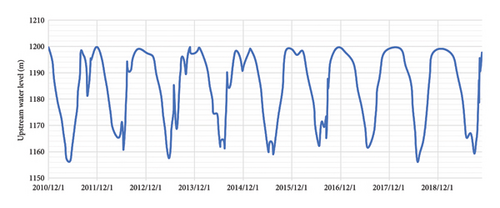
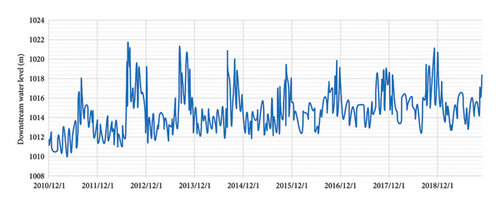
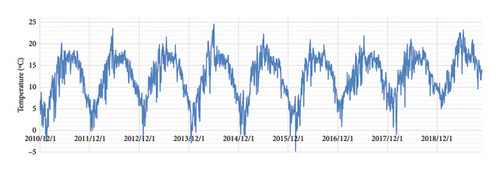
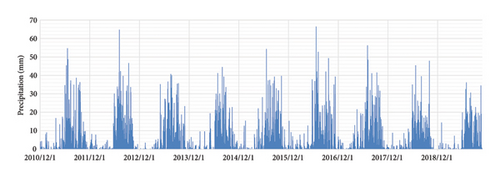
3.2. Seepage Pressure Prediction Results
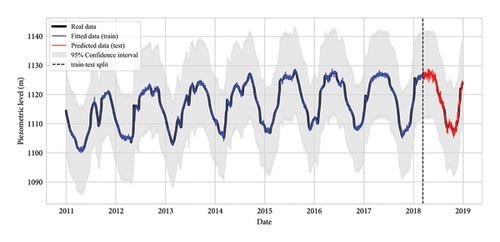
| Measurement point | Evaluation metrics | Train | Test |
|---|---|---|---|
| Point A | Root mean square error (RMSE) (m) | 0.2659 | 0.3725 |
| Mean absolute error (MAE) (m) | 0.1568 | 0.4511 | |
| Coefficient of determination (R2) | 0.9913 | 0.9766 | |
| Point B | Root mean square error (RMSE) (m) | 0.3026 | 0.5075 |
| Mean absolute error (MAE) (m) | 0.2254 | 0.5578 | |
| Coefficient of determination (R2) | 0.9856 | 0.9733 | |
| Point C | Root mean square error (RMSE) (m) | 0.2018 | 0.2241 |
| Mean absolute error (MAE) (m) | 0.1346 | 0.4059 | |
| Coefficient of determination (R2) | 0.9945 | 0.9856 | |
Based on the evaluation metrics and graphical visualization, it is clear that the AT-LSTM model demonstrates excellent predictive performance for the variations in seepage pressure data, effectively forecasting changes in dam seepage pressure.
3.3. Comparison With Prediction Results From Four Other Models
A comparative evaluation was conducted between the improved model and LSTM, Random Forest, and two univariate prediction models (ARIMA and Prophet). As shown in Table 2, on the test set, the AT-LSTM model improved the R2 by 4.7%, 3.5%, 14.7%, and 14.3% compared with the LSTM, GRU, ARIMA, and Prophet models, respectively, verifying the accuracy of AT-LSTM.
| Measurement point | Model | Training set | Validation set | ||||
|---|---|---|---|---|---|---|---|
| RMSE | MAE | R2 | RMSE | MAE | R2 | ||
| Point A | AT-LSTM | 0.266 | 0.157 | 0.991 | 0.373 | 0.451 | 0.978 |
| LSTM | 2.055 | 1.854 | 0.902 | 1.052 | 0.931 | 0.934 | |
| GRU | 3.579 | 3.112 | 0.918 | 2.036 | 1.878 | 0.945 | |
| Prophet | 10.524 | 6.539 | 0.913 | 4.255 | 2.987 | 0.853 | |
| ARIMA | 23.891 | 13.524 | 0.875 | 15.297 | 9.032 | 0.856 | |
| Point B | AT-LSTM | 0.303 | 0.225 | 0.986 | 0.508 | 0.558 | 0.973 |
| Point C | AT-LSTM | 0.202 | 0.135 | 0.995 | 0.224 | 0.406 | 0.986 |
3.4. The Impact of Rainfall Lag Treatment on Dam Prediction
By solving the lagged time series, we obtain the maximum correlation lag periods k∗ for three measurement points (A, B, and C), which are 6.3 days, 5.5 days, and 7.0 days, respectively. We compare the results before and after applying lag treatment in the model to explore the impact of lag handling on the prediction model. The specific details are shown in Table 3.
| Measurement point | Lag period (days) | R2 of the prediction after lag treatment | R2 of the prediction without lag treatment |
|---|---|---|---|
| Point A | 6.3 | 0.978 | 0.968 |
| Point B | 5.5 | 0.973 | 0.970 |
| Point C | 7.0 | 0.986 | 0.971 |
As shown in Table 3, lag treatment has improved prediction accuracy to some extent, with this effect being more evident at measurement point C. Although the overall impact is not very high (likely because the weight of rainfall in the prediction model is relatively low), it reflects the existence of the lag effect of rainfall on dam seepage.
3.5. Analysis of Attention Weights for Each Factor
In fact, the impact of various external factors on dam seepage differs across periods, but the weights recognized by general prediction algorithms are mostly fixed. The AT-LSTM model addresses this issue effectively. With the intervention of the attention mechanism, it can dynamically adjust the weights of each influencing factor at different time steps, thereby improving the model’s prediction accuracy. Given the long time span of the overall data, for clearer presentation, this paper uses measurement point A as an example and selects data from 2016 to 2017 to demonstrate the dynamic changes in attention weights by month, which is shown in Figure 13.
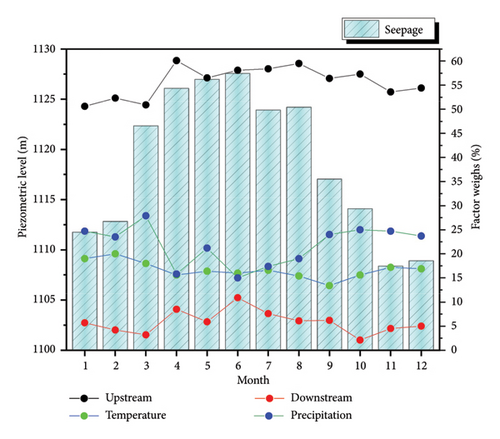
The figure compares the changes in weights for four influencing factors and seepage (the aging factor is not discussed here due to its low contribution to the model). It can be seen that the attention weights of these four influencing factors change dynamically over time. The upstream water level consistently holds a significant weight on seepage, fluctuating between 50% and 70%, while the downstream water level has a much smaller impact, with its weight remaining below 10%. Meanwhile, the weight of rainfall is slightly higher than that of temperature, and the weight variations for the four factors remain generally stable. Interestingly, during the local flood season (May–August), which coincides with the peak of dam seepage, the impact weights of upstream and downstream water levels increase, reflecting that water level may be a more direct factor influencing dam leakage.

3.6. Testing the Early Warning Effectiveness of the Simulated Risk
3.6.1. Determination of Parameters for the Improved CUSUM Algorithm
- 1.
Historical normal data are collected to analyze the distribution characteristics of the residuals, and it is found that the residuals approximately follow a normal distribution x ~ N(μ, σ2). Calculations show that the mean of the 100-day residual sample data is close to 0, with a standard deviation of approximately 0.068, which is shown in Figure 14.
- 2.
Considering that the residuals at each time point follow a normal distribution N(μ, σ2), when these residuals are accumulated, the cumulative residual Sn is composed of multiple independent normally distributed random variables as follows:
(16)
According to the central limit theorem, the cumulative residual Sn will also tend toward a normal distribution , with a mean μs = 0, and a standard deviation . Based on 3σ principle, there is a 99.73% probability that the cumulative residual threshold will fall within three standard deviations. We set the residual threshold to 3σs = 2.04, and this setting performs well in later tests.
3.6.2. Testing the Model’s Early Warning Effectiveness
By simulating a seepage risk scenario based on historical accident data, this study examines the effectiveness of the LSTM-CUSUM model for early warning, which are shown in Figure 15.

The results show that the algorithm, combined with LSTM predictions, can effectively identify gradual changes and provide early warnings for sudden risk trends. In the simulation, hidden seepage began around day 60, and the CUSUM model detected a significant trend change around day 72 through accumulated residuals. This provided a warning about 8 days earlier than traditional anomaly detection methods.
3.6.3. Comparison of Model Performance and Exploration of Reasons
The improved CUSUM model and other algorithms are compared and analyzed through multiple model experiments to evaluate their performance, and the results are shown in Table 4.
| Evaluation metrics | Improved CUSUM | Traditional CUSUM | DBSCAN | Isolation forest |
|---|---|---|---|---|
| Average warning time | 12 days | 11 days | 20 days | 16 days |
| Noise tolerance | High | Low | Moderate | Moderate |
| False alarm rate | < 10% | < 25% | < 10% | < 5% |
The improved CUSUM and traditional CUSUM (with identical parameters but without control functions) are analyzed using the residual sequence, while other algorithms are analyzed using normally collected monitoring data. As shown in Table 4, the improved CUSUM algorithm effectively overcomes the shortcomings of the traditional CUSUM algorithm and outperforms other traditional anomaly detection models.
Reason analysis: in terms of early warning time, the improved CUSUM algorithm, by continuously accumulating prediction residuals, can promptly capture subtle changes in seepage, thus providing quicker anomaly alerts. Although traditional CUSUM can detect mean changes, it is less resistant to noise. DBSCAN and Isolation Forest, when dealing with gradually changing seepage data, often experience delayed warnings due to their high data distribution requirements. Moreover, in terms of robustness, the improved CUSUM can effectively filter out occasional noise and periodic influences (such as water level fluctuations and precipitation), focusing on anomalies caused by changes in the dam structure. This results in stronger stability in complex environments. In contrast, DBSCAN and Isolation Forest are more susceptible to noise interference, leading to false alarms.
3.7. Sensitivity Analysis of Improved CUSUM Parameters
-
Sliding window period: the window period in the CUSUM algorithm defines how many observations are used to accumulate the residuals. A smaller window period can respond more quickly to changes but may be affected by noise, leading to false alarms. A larger window period responds more smoothly to changes, reducing false alarms, but may delay the detection of anomalies.
-
Cumulative residual threshold: the choice of control limits (thresholds) determines the sensitivity of the algorithm. A smaller threshold can detect even small changes in the mean more sensitively, but it may increase the risk of false alarms. A larger threshold may miss smaller changes but reduce false alarms.
In the following, based on the reasonable parameters successfully validated earlier, we adjust these two parameters and observe the model’s response under different combinations : [T, Supper], and the results are shown in Figure 16.
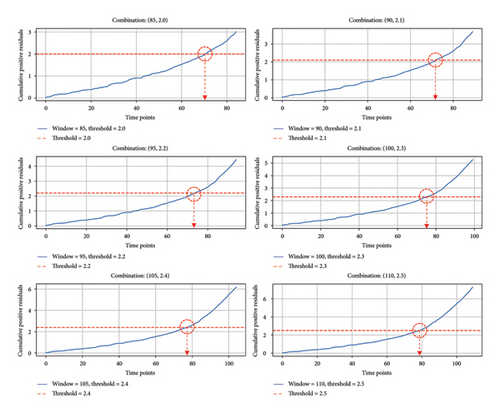
C : [85, 2.0] identifies a significant trend change around Day 70, C : [90, 2.1] around Day 71, C : [95, 2.2] around Day 73, C : [100, 2.3] around Day 75, C : [105, 2.4] around Day 76, and C : [110, 2.5] around Day 78, all occurring prior to the conventional anomaly detection on Day 80. Therefore, the various parameter combinations selected for this simulated seepage risk scenario can achieve early warning effects, indicating that the model has a certain degree of flexibility in parameter selection.
4. Conclusion and Outlook
- 1.
The introduction of an attention mechanism in the LSTM network effectively enhances the model’s predictive accuracy. The AT-LSTM model achieves a goodness of fit of 0.98, with a root mean square error of approximately 0.89 m and a mean absolute error of around 0.62 m. Compared with LSTM, GRU, ARIMA, and Prophet models, the R2 value of AT-LSTM improves by 4.6%, 3.3%, 14.3%, and 14.1%, respectively.
- 2.
The improved CUSUM algorithm effectively identifies trend changes in advance due to the residual accumulation amplification effect and the configuration of the acceptance function, with a certain degree of flexibility in parameter combinations. It can save more than half of the response time compared to commonly used anomaly detection algorithms.
- 3.
Careful consideration is needed regarding parameter selection for the improved CUSUM model; overly small parameter combinations may lead to excessive sensitivity, while overly large combinations may result in insensitivity.
- 4.
For dam seepage prediction, more influencing factors could be considered, such as dam construction materials, foundation geology, and seismic activity.
- 5.
For the improved CUSUM algorithm’s early warning of seepage trend changes, future work could explore integrating specific dam structures, and local hydrological conditions, using cross-validation or statistical methods to find optimal parameter combinations.
Conflicts of Interest
The authors declare no conflicts of interest.
Funding
This research was funded by the National Natural Science Foundation of China (51909204) and Shanxi Natural Science Research Project (20220302121321).
Acknowledgments
The authors acknowledge the National Natural Science Foundation of China (Grant no: 51909204) and Shanxi Natural Science Research Project (20220302121321).
Open Research
Data Availability Statement
The data used to support the findings of this study are available from the corresponding author upon reasonable request.



